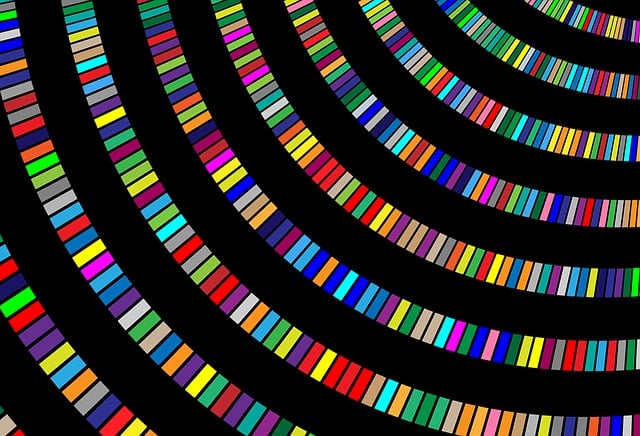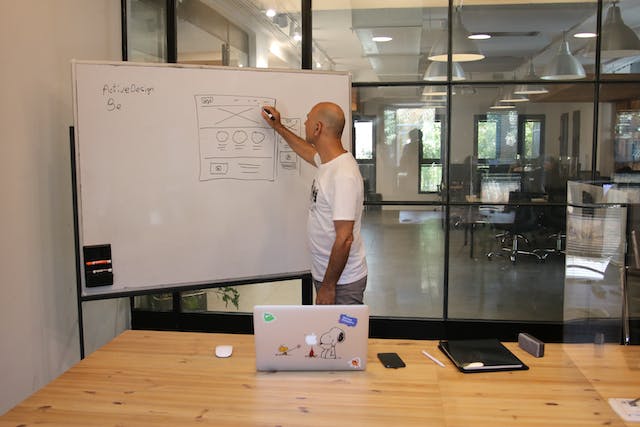If you’re interested in or familiar with UX research, you may have encountered the term ‘user journey mapping.’
User journey mapping refers to the process of detailing a user’s experience with a product in order to accomplish goals. This map type is a common UX research tool that can determine the quality of your user’s experiences.
Of course, UX research is an immeasurably vital component of a digital product’s UX design. One of the most helpful research tools is user journey maps. So, with that being said, let’s uncover the meaning of and share examples of user journey maps. We shall also explore the stages and benefits of it, as well as helpful tools and templates.
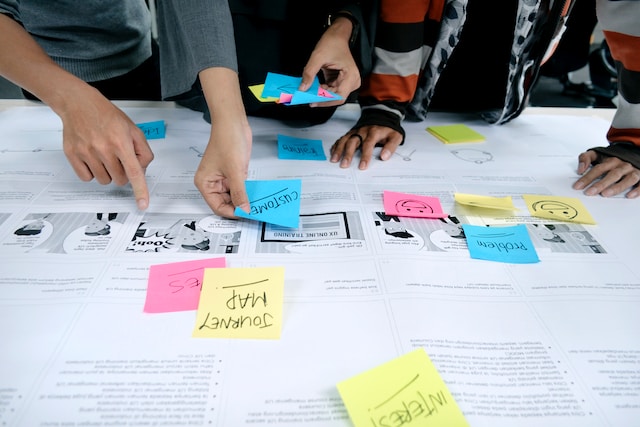
What Is a User Journey Map?
We shall now explore the meaning of a user journey map, also known as a customer journey map.
So, what is a user journey map? It is a visualization of a user’s process to accomplish a task. In other words, a user journey map visually represents the user flow through a site.
Reliant on unique contexts, customer journey maps can come in various formats. UX designers use them in different ways.
Usually, user journey maps display a series of user actions, which ultimately form a timeline. This timeline is further developed by implementing users’ thoughts, opinions, and emotions.
Conclusively, you’ll end up with a narrative that serves as an experience map of your user’s journey with your product.

What Is User Journey Mapping in Design Thinking?
Although slight, there is a slight difference regarding user journey mapping in design thinking.
In design thinking, customer journey mapping visually represents a user’s experience when interacting with a digital product. Focusing on the user’s experience uncovers valuable insights into vital aspects of customer touchpoints. You will reveal users’ needs, emotions, encountered problems, and moments of enjoyability.
This method of UX research helps UX researchers empathize with their users, which is the primary aim of design thinking.
When executed effectively, user journey maps ensure your design solutions display user-centricity and adhere to your brand’s or company’s goals.
The Components of a User Journey Map
Several components make up a customer journey map. Below, we shall explore those components to give you a better understanding of the usefulness of user journey mapping.
User Personas
User personas, also known as buyer personas or actors, include the individual embarking on the journey. This actor is at the center of your user journey map — it’s their perspective that you’re trying to understand.
These individuals can be users of your products, or they can be prospective customers. You can even target a singular individual or a group of people.
To capture multiple perspectives, you will need to build several journey maps. By doing this, you can gather well-rounded data from several user types. This data will increase your chances of creating an accessible, intuitive user experience.
Scenarios
The scenarios describe the circumstances that the user journey map visualizes. These scenarios are associated with the actor’s goals, needs, and expectations.
Scenarios also include what the actor is trying to do. Scenarios can be real, like if you wish to create a UX journey map for an existing product. However, scenarios can also involve anticipated product user journeys in the design stage. These scenarios may involve a series of events or a description of a process involving transitions over a given period.
Remember, by understanding the actors’ needs, they spend less on marketing resources by reducing the users’ learning curves.
Phases
User journey phases refer to the different stages of the journey, depending on the scenario.
For instance, consider a scenario for Spotify. The phases would be visit, listen, discover, and share.
While the exact stages may differ depending on your company’s goals, below, we have outlined the typical journey map:
- The awareness stage.
- The consideration stage.
- The evaluation stage.
- The purchase stage.
- The onboarding stage.
- The engagement stage.
- The retention stage.
- The advocacy stage.
This component of the user’s journey helps you visualize how the customer progresses through the scenario to accomplish their tasks. Specifically, phases organize the actor’s thoughts, emotions, and actions.
You can use this data to conceptualize how your company can guide users toward their goals within your product.
Emotions, Mindsets, and Actions
The emotions, mindsets, and actions of your actors will be mapped out within each of the journey phases.
Product teams have been known to ignore their users’ emotional states. Data from logical decisions is incredibly useful.
However, to increase your product’s enjoyability, you must also prioritize your users’ emotions. After all, your users are humans, swayed by emotions and personal biases.
- Emotions
Emotions are plotted as singular lines across the journey phase. Every ascension or descension represents changes in the user’s emotional state. Thus revealing any pain points in the user’s journey. This will help you contextualize your users on a personal, human level.
- Mindsets
Mindsets typically appear as comments tethered to the singular ‘emotional state’ lines. They usually include the user’s thoughts, motivations, questions, and potential frustrations at different journey phases. To implement the user’s mindset most effectively, it is ideal to capture their comments word-for-word.
- Actions
Simply put, actions are the actual steps that the user takes to accomplish their goals. UX researchers employ narratives to portray users’ actions rather than graphical visualizations. This narrative typically involves every decision the user makes during each phase of their journey.
Opportunities
Opportunities are insights gained from mapping the user’s journey. You will use these insights to improve the user’s experience.
Opportunities help product teams ask themselves the necessary questions to refine their products:
- Is our product frustrating or confusing the user?
- Where are the biggest opportunities arising?
- How are we going to test the improvements we make to our products?
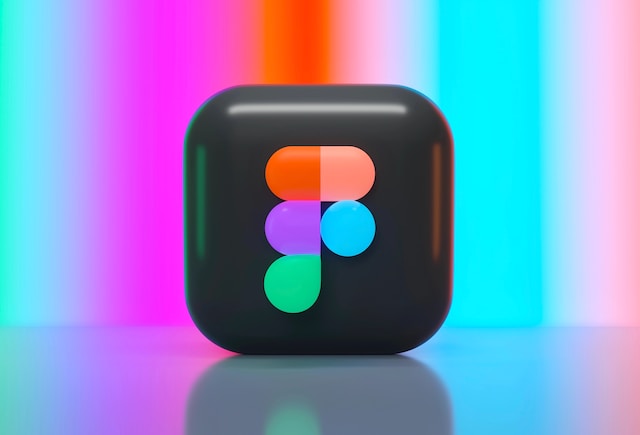
A User Journey Mapping Tool
Unfortunately, we can’t tell you which user journey mapping tool is the best for your research. After all, it is subjective, and only you can know which tool best suits your aims.
However, we can illuminate what features your chosen tool should have. Before we provide a list of excellent user journey mapping tools, we can illuminate what features your tool should have.
- Your tool should allow you to create accurately detailed visualizations of every step of a user’s journey.
- Your tool should exhibit collaborative functionalities.
- Your tool should be easy to understand and should exhibit a straightforward user interface.
- You should be able to integrate your mapping tool with other software.
- The ideal tool would offer customizable templates.
- The ideal tool also provides opportunity analytics.
Now that you know which features to look for, you should consider these effective user journey-mapping tools:
How To Use a User Journey Map Template
Employing a customizable user journey map template is incredibly useful. However, you must know how to tailor your template to your business’s goals.
Here’s how you should customize your template:
- Set a clear objective for your user journey map. Ensure that it aligns with your company’s goals.
- Clarify your user personas and what kind of user experience your product will address. Highlight target users by employing user research to determine the user’s experience at every one of the customer touchpoints. As a suggestion, you should conduct customer interviews, local meet-ups, user testing, and surveys.
- Implement the appropriate stages and goals for each journey map, including each user type.
- List out your product’s touchpoints.
- Gather logical and emotional data from your users, as well as their feedback, to illustrate points of joy and frustration.
- Determine pain points from your feedback.
- Identify areas for improvement and begin making those key refinements!
User Journey Map Examples
Here are two examples of user journey maps for your own UX research inspiration.
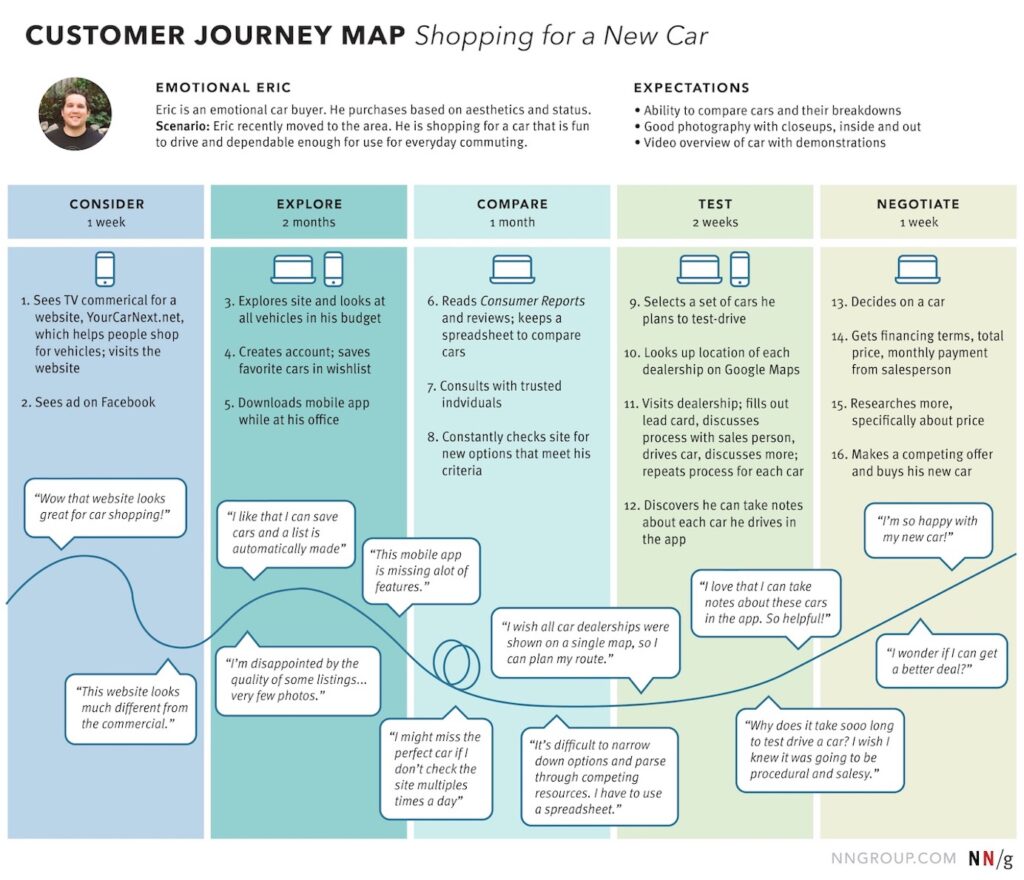
Nielsen Norman Group (NN/group)
NN/group’s user journey map is very simple, easy to understand, and thus easy to recreate. This journey map serves as an optimal map template. It details the user’s journey as they search for a new car.
This is due to how it efficiently demonstrates a journey map’s most crucial components. Specifically, the journey’s phases (consider, explore, compare, test, and negotiate) are clearly outlined.
The user’s emotional state is easily represented, flaunting comments that detail every user’s thoughts at different stages.
This user map also exhibits a high-level narrative of the user’s experience, making it incredibly easy to situate opportunities.
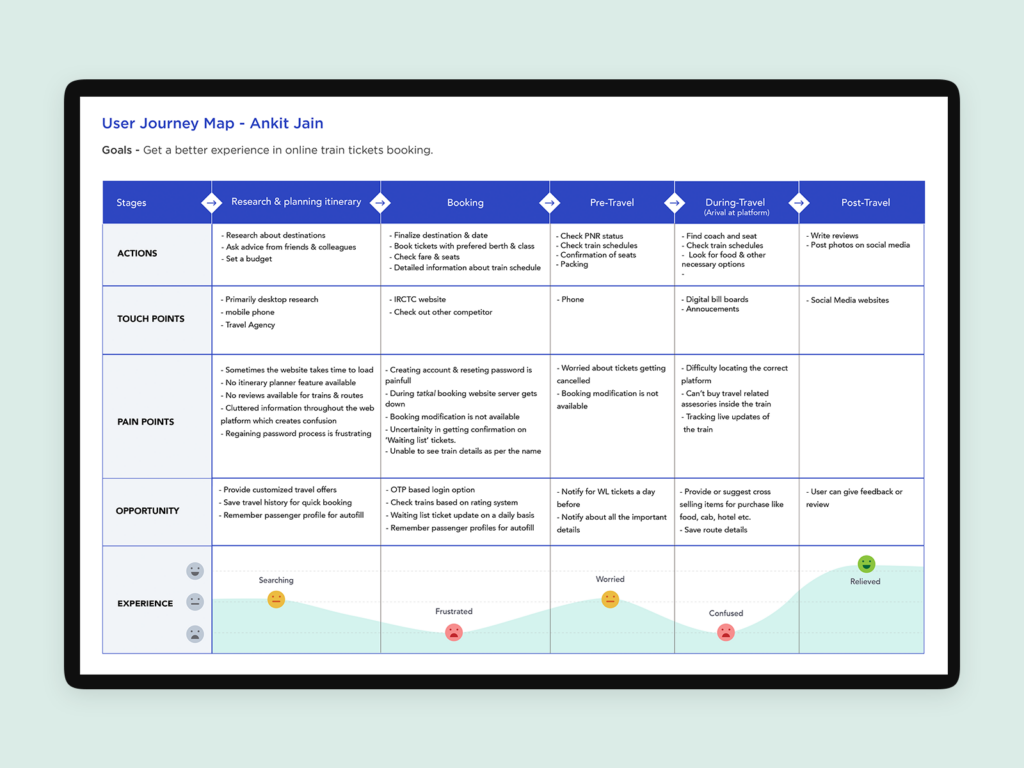
Indian Railways
Now, we shall look at a user journey map for Indian Railways. Deepika Sinha created this map to improve the UX design of Indian Railways’s mobile app.
The first thing you notice is how clear and concise it is. This is incredibly important when considering the map’s shareability. Your colleagues and stakeholders should easily understand your data.
This user journey map is visually appealing, with colors and symbols that quickly indicate the users’ emotional states.
This map clearly details the experience of booking train tickets through an app. It also efficiently demonstrates the users’ pain points and opportunities for improvement.
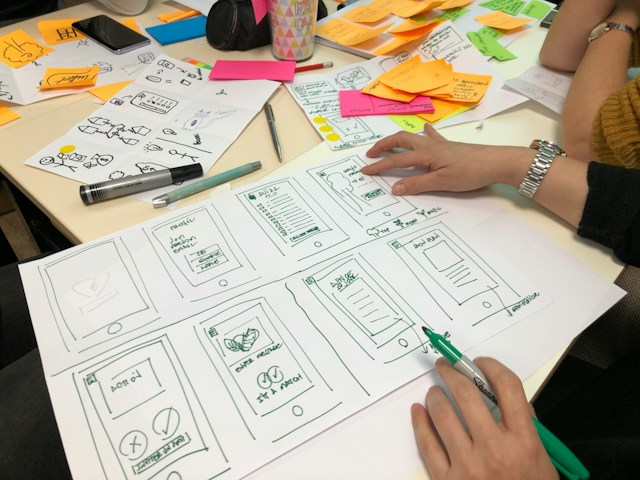
User Journey Mapping: Optimizing Your User’s Experience
Regardless of which templates or tools you use, you must remember one thing: you must always prioritize the user.
The key takeaway is not to get lost in the desperation to find straightforward, logical data.
Understanding user journey mapping means that you understand the importance of knowing your users on a personal, human level.
Are you looking for products that flaunt excellent user journey mapping? Consider Page Flows.
Page Flows is an incredibly useful resource for interaction design inspiration. From Monzo to music, Page Flows excels at creating engaging, intuitive user experiences.
Page Flows has garnered over 1,000 happy customers from esteemed brands via our unparalleled user flow design decisions. We pride ourselves on our ability not only to meet but also to exceed users’ expectations.
Get started today to access our growing library of user flow recordings and finally stay up-to-date with current design trends.



